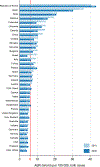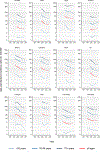Is gastric cancer becoming a rare disease? A global assessment of predicted incidence trends to 2035
- PMID: 32001553
- PMCID: PMC8520492
- DOI: 10.1136/gutjnl-2019-320234
Is gastric cancer becoming a rare disease? A global assessment of predicted incidence trends to 2035
Abstract
Objectives: The incidence of gastric cancer continues to decrease globally, approaching levels that in some populations could define it as a rare disease. To explore this on a wider scale, we predict its future burden in 34 countries with long-standing population-based data.
Methods: Data on gastric cancer incidence by year of diagnosis, sex and age were extracted for 92 cancer registries in 34 countries included in Cancer Incidence in Five Continents Plus. Numbers of new cases and age-standardised incidence rates (ASR per 100 000) were predicted up to 2035 by fitting and extrapolating age-period-cohort models.
Results: Overall gastric cancer incidence rates are predicted to continue falling in the future in the majority of countries, including high-incidence countries such as Japan (ASR 36 in 2010 vs ASR 30 in 2035) but also low-incidence countries such as Australia (ASR 5.1 in 2010 vs ASR 4.6 in 2035). A total of 16 countries are predicted to fall below the rare disease threshold (defined as 6 per 100 000 person-years) by 2035, while the number of newly diagnosed cases remains high and is predicted to continue growing. In contrast, incidence increases were seen in younger age groups (below age 50 years) in both low-incidence and high-incidence populations.
Conclusions: While gastric cancer is predicted to become a rare disease in a growing number of countries, incidence levels remain high in some regions, and increasing risks have been observed in younger generations. The predicted growing number of new cases highlights that gastric cancer remains a major challenge to public health on a global scale.
Keywords: epidemiology; gastric cancer; helicobacter pylori.
© Author(s) (or their employer(s)) 2020. No commercial re-use. See rights and permissions. Published by BMJ.
Conflict of interest statement
Competing interests: None declared.
Figures



References
-
- Bray F, Ferlay J, Soerjomataram I, Siegel RL, Torre LA, Jemal A. Global cancer statistics 2018: GLOBOCAN estimates of incidence and mortality worldwide for 36 cancers in 185 countries. CA Cancer J Clin 2018;68:394–424. - PubMed
-
- Hooi JKY, Lai WY, Ng WK, Suen MMY, Underwood FE, Tanyingoh D, et al. Global Prevalence of Helicobacter pylori Infection: Systematic Review and Meta-Analysis. Gastroenterology 2017;153:420–9. - PubMed
-
- Hamashima C, Systematic Review G, Guideline Development Group for Gastric Cancer Screening G. Update version of the Japanese Guidelines for Gastric Cancer Screening. Jpn J Clin Oncol 2018;48:673–83. - PubMed
-
- Jun JK, Choi KS, Lee HY, Suh M, Park B, Song SH, et al. Effectiveness of the Korean National Cancer Screening Program in Reducing Gastric Cancer Mortality. Gastroenterology 2017;152:1319–28 e7. - PubMed
-
- Ferlay J, Colombet M, Bray F. Cancer Incidence in Five Continents, CI5plus: IARC CancerBase No. 9. Lyon, France: International Agency for Research on Cancer, 2018.
Publication types
MeSH terms
Grants and funding
LinkOut - more resources
Full Text Sources
Other Literature Sources
Medical
